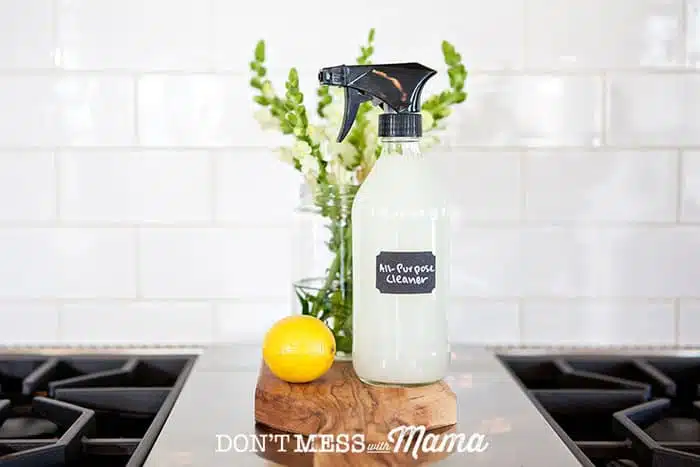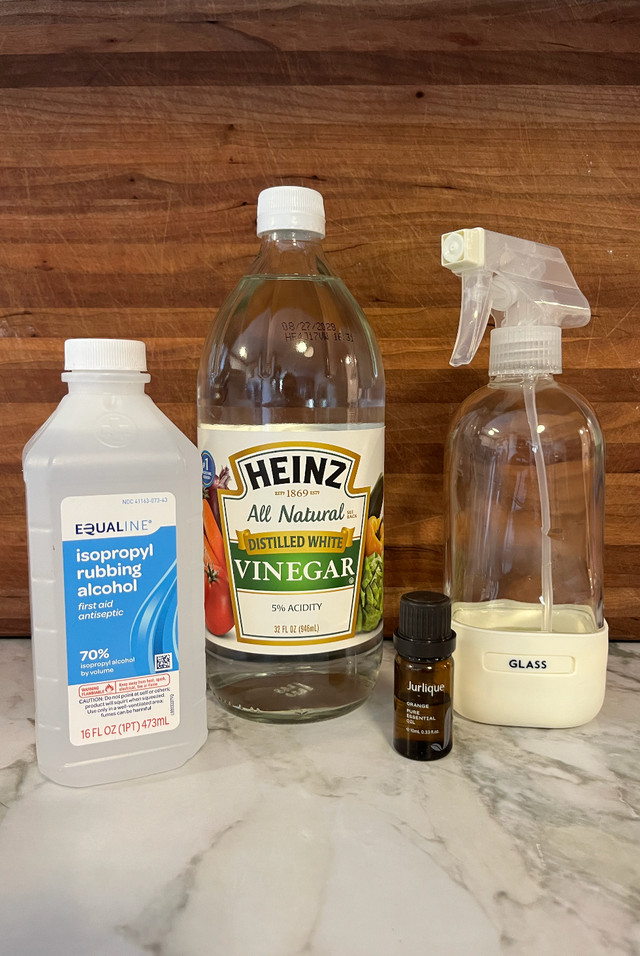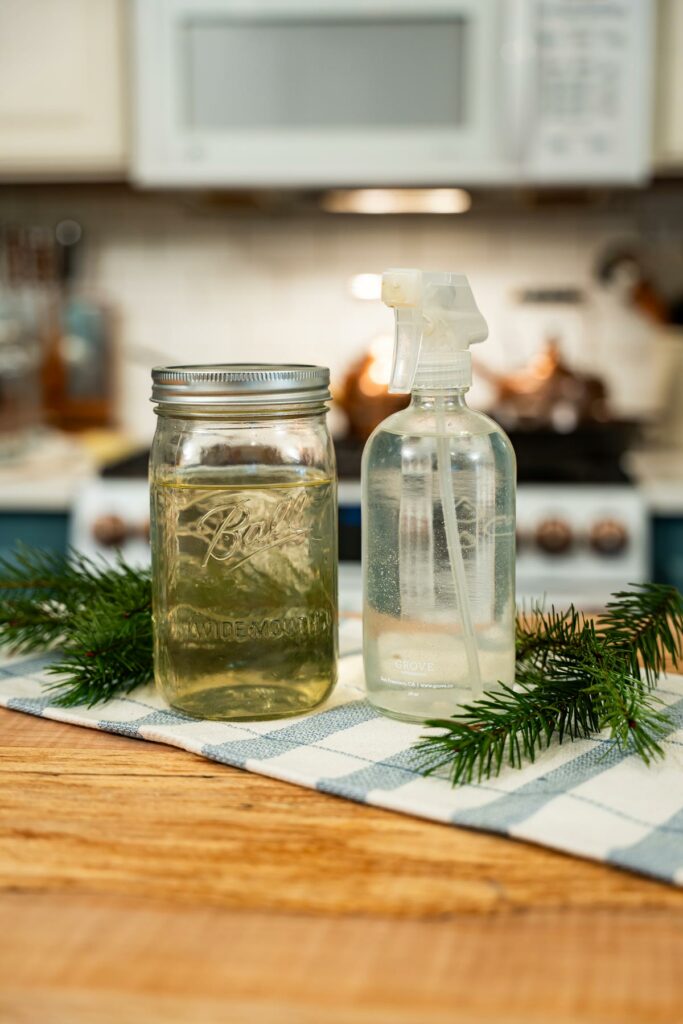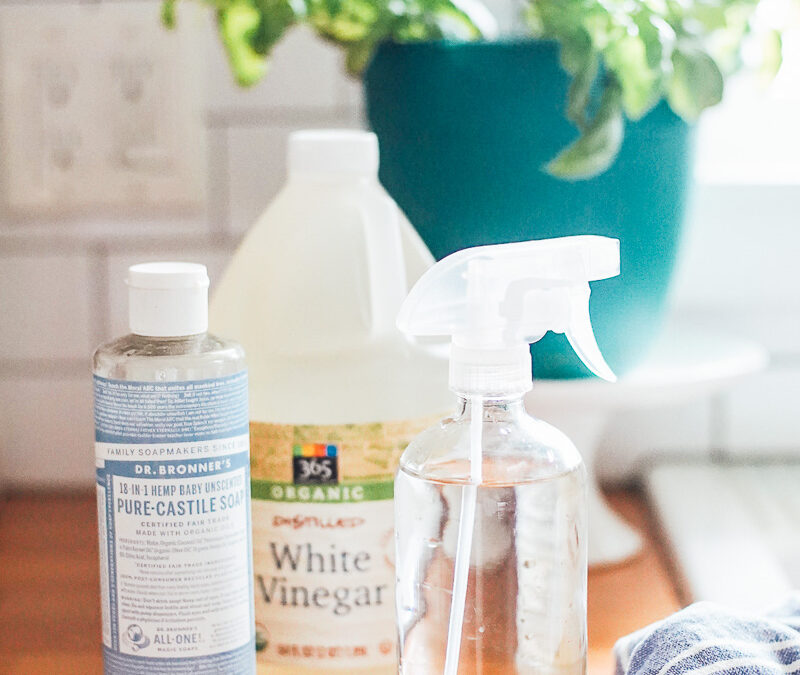Are you tired of spending money on expensive kitchen cleaners filled with harsh chemicals? What if you could create an effective, eco-friendly cleaner using something you probably already have in your pantry?
That’s right—vinegar! This humble household staple is more powerful than you might think. Imagine effortlessly wiping away grease, grime, and bacteria without worrying about harmful toxins in your home. With just a few simple steps, you can transform ordinary vinegar into your go-to solution for a spotless kitchen.
Keep reading to discover how you can make your own kitchen cleaner with vinegar and enjoy a sparkling clean space that’s safe for your family and the planet.
Benefits Of Using Vinegar
Vinegar is a powerhouse ingredient that can transform your kitchen cleaning routine. Its benefits go beyond just a sparkling clean. You might wonder why everyone isn’t using it already. Let’s dive into the advantages of using vinegar as a kitchen cleaner.
Natural Cleaning Properties
Vinegar is a natural acid. It cuts through grease and grime effortlessly. Say goodbye to stubborn stains and residues. You’ll love how easily it tackles tough spots.
Have you ever scrubbed a sticky spill for what feels like eternity? Vinegar can make that chore a breeze. Its acidic nature breaks down organic materials quickly. Next time, try vinegar and see the magic.
Cost-effectiveness
Cleaning products can be expensive. Vinegar is a budget-friendly alternative. With a bottle of vinegar, you can clean your entire kitchen for a fraction of the cost.
Think about all those pricey cleaners you’ve bought. Vinegar can replace most of them. It’s a simple swap that saves money and space.
Environmental Impact
Vinegar is eco-friendly. It’s a natural product that doesn’t harm the environment. Imagine reducing your carbon footprint while cleaning.
Have you considered the impact of chemicals in regular cleaners? Vinegar offers a greener solution. It’s a small step towards a healthier planet.
Why not give vinegar a try today? You might find it’s just what your kitchen needs. It’s affordable, effective, and kind to the environment. What more could you ask for?
Essential Ingredients
Creating your own kitchen cleaner with vinegar is simple and cost-effective. It uses common ingredients found in most households. The essential ingredients are easy to gather. They promise a powerful cleaning solution. Below, we explore what you need to get started.
Types Of Vinegar
White vinegar is the top choice for cleaning. It has a high acidity level. This makes it an excellent cleaner. Apple cider vinegar is an alternative. It has a pleasant smell. But it may leave stains on light surfaces. Both types work well, but white vinegar is often preferred.
Other Required Ingredients
Water is essential to dilute the vinegar. This reduces its strong smell. It also protects surfaces from damage. A spray bottle is useful. It makes application easy and even. Tap water is fine. Distilled water is better for long-term storage.
Optional Additives
Lemon juice can be added for a fresh scent. It boosts cleaning power too. Essential oils are another option. They add fragrance and antimicrobial properties. Tea tree and lavender oils are popular choices. Baking soda can be used for tough stains. It works well on greasy surfaces.
Tools And Equipment
Creating a homemade kitchen cleaner with vinegar is not only cost-effective but also environmentally friendly. To make this DIY cleaner, you’ll need some basic tools and equipment that you probably already have at home. These items are essential to ensure you mix the right proportions and apply the solution effectively. Ready to see what’s in your toolkit?
Measuring Tools
Precision is key when mixing your cleaner. Measuring cups and spoons help you get the right amount of vinegar and water. You don’t need fancy equipment—your everyday kitchen measuring tools will do. Remember the time you tried baking without measuring your ingredients? Let’s not repeat that in our cleaner mix!
Mixing Containers
Once you’ve measured your ingredients, you’ll need a container to mix them. A simple bowl or a pitcher can work wonders. Make sure it’s large enough to hold your mixture without spilling. Have you ever tried mixing something in a container that’s too small? It’s like trying to fit a puzzle piece where it doesn’t belong.
Spray Bottles
Now that your cleaner is ready, it’s time to store it in a spray bottle for easy use. Choose a bottle with a good spray nozzle for even application. Ever struggled with a bottle that barely sprays? Investing in a quality spray bottle can save you from that frustration. Ask yourself, how much easier would cleaning be with the right spray bottle?
With these tools and equipment, you’re all set to make your own kitchen cleaner. Are you excited to see how a simple mix can transform your cleaning routine? Let’s get started and bring some sparkle to your kitchen!

Credit: dontmesswithmama.com
Step-by-step Preparation
Create a homemade kitchen cleaner with vinegar using simple steps. Mix equal parts vinegar and water in a spray bottle. Add a few drops of essential oil for fragrance, then shake well. Your natural cleaner is ready to tackle kitchen grime effectively.
Creating your own kitchen cleaner with vinegar is a simple, cost-effective way to maintain a spotless kitchen. Vinegar, a natural disinfectant, helps eliminate grease and grime without harsh chemicals. Let’s dive into the step-by-step preparation of this versatile cleaner that will leave your kitchen sparkling.Measuring Ingredients
Start by gathering your ingredients. You’ll need white vinegar and water. A 1:1 ratio works wonders for most cleaning tasks. Measure one cup of vinegar and one cup of water. This ratio ensures your cleaner is powerful yet gentle enough for various surfaces. Consider adding a few drops of your favorite essential oil for a pleasant scent. Lavender or lemon can make your kitchen smell fresh and inviting.Mixing The Solution
Once you have your ingredients measured, it’s time to mix them. Find a clean spray bottle. A repurposed bottle works great, just ensure it’s thoroughly rinsed. Pour the vinegar and water into the bottle using a funnel to prevent spills. Add the essential oil if you opted for it. Shake the bottle gently to combine the ingredients. This step ensures the oil blends well with the solution.Storage Guidelines
Proper storage keeps your cleaner effective. Store the bottle in a cool, dark place to maintain the potency of the vinegar. Label the bottle clearly with the contents and date of preparation. This helps you remember what’s inside and when you made it. If you have kids or pets, ensure the bottle is out of their reach. Safety first, always! Creating your own cleaner is not only empowering but also eco-friendly. Have you ever thought about how much waste you reduce by reusing bottles and minimizing chemical usage? Give it a try and enjoy the satisfaction of a clean kitchen, naturally achieved with your homemade solution.Application Techniques
Vinegar is a simple, effective cleaner for your kitchen. Its natural properties make it a favorite for many. Learn how to apply it best for different needs. Follow these tips for a sparkling kitchen.
Surface Cleaning Tips
Mix equal parts vinegar and water. Use a spray bottle for easy application. Spray the solution on countertops and tables. Wipe with a clean cloth. This mix works on most surfaces. Avoid using on granite or marble.
Stain Removal Methods
Stubborn stains can be tricky. Apply undiluted vinegar directly to the stain. Let it sit for a few minutes. Scrub gently with a sponge or brush. Rinse with warm water. Repeat if needed for tough stains.
Handling Tough Spots
Some spots need extra care. Boil vinegar in the microwave for tough grease. The steam helps loosen the grime. Wipe away with a cloth. For burnt-on spots, soak with vinegar overnight. Scrape gently in the morning.

Credit: www.goodhousekeeping.com
Safety Considerations
Ensure good ventilation when using vinegar for cleaning. Keep vinegar away from eyes and skin to prevent irritation. Always store vinegar out of children’s reach to maintain safety.
Vinegar is a fantastic all-natural option for cleaning your kitchen, but keeping safety in mind is crucial. While it’s a household staple, using it improperly can lead to unintended consequences. Let’s dive into some essential safety considerations so you can clean effectively and safely.Proper Handling Of Vinegar
When you’re dealing with vinegar, handling it with care should be your priority. It’s acidic, so wear gloves to protect your skin from irritation. Ever splashed vinegar in your eyes accidentally? It stings! Always pour vinegar slowly to avoid splashing. Remember to store it safely. Use a secure, child-proof cabinet, especially if you have young ones around. Keep it cool and dry to maintain its effectiveness.Precautions For Different Surfaces
Vinegar works wonders on many surfaces but can be harsh on delicate ones. Avoid using vinegar on marble or granite countertops, as it can dull the finish. It’s a lesson I learned the hard way after noticing etching on my stone countertop. Test a small area first. This simple step can save you from costly damages. Consider the surface’s material and finish before applying vinegar. Is it better to choose another cleaning method for specific surfaces in your kitchen?First Aid Measures
Accidents happen, and being prepared is key. If vinegar gets in your eyes, rinse them immediately with plenty of water. Have you ever wondered what to do if someone accidentally ingests vinegar? Encourage them to drink water and seek medical advice if discomfort persists. For skin irritation, wash the affected area with soap and water. Make a mental note of these measures to ensure you’re ready to handle any mishap. By keeping these safety tips in mind, you can use vinegar confidently in your kitchen cleaning routine. What’s your favorite vinegar cleaning hack that makes your kitchen sparkle without compromising safety?
Credit: melissaknorris.com
Frequently Asked Questions
What Are The Benefits Of Using Vinegar As A Cleaner?
Vinegar is a natural, eco-friendly cleaner that removes stains, odors, and bacteria. It’s safe for most surfaces and cost-effective. With its acidic nature, vinegar breaks down grime effectively. Additionally, vinegar is a versatile ingredient, making it ideal for various kitchen cleaning tasks.
How Do I Make A Vinegar Kitchen Cleaner?
To make a vinegar kitchen cleaner, mix equal parts of white vinegar and water. Pour the solution into a spray bottle. Use it to clean countertops, sinks, and appliances. For stubborn stains, let the solution sit for a few minutes before wiping away.
Is Vinegar Safe For All Kitchen Surfaces?
While vinegar is safe for many surfaces, avoid using it on granite, marble, and natural stone. The acidity can damage these materials. Instead, use a pH-neutral cleaner for such surfaces. Always test on a small area first to ensure compatibility.
Can Vinegar Remove Kitchen Odors Effectively?
Yes, vinegar effectively neutralizes kitchen odors. Place a bowl of vinegar in the kitchen overnight to absorb smells. You can also use vinegar to clean trash cans and drains. Its natural deodorizing properties help eliminate lingering odors.
Conclusion
Vinegar makes cleaning easy and cheap. It fights grime and germs. Using vinegar saves money and protects health. It’s also eco-friendly, reducing chemical use at home. Try making your own cleaner. Mix vinegar with water. Add a few drops of lemon or essential oils.
Your kitchen will sparkle. Start today. Make your kitchen cleaner with vinegar. It’s simple and effective. Anyone can do it. No fancy equipment needed. Cleaner surfaces, safer home. Enjoy a fresh kitchen. Keep it clean, naturally. It’s worth it.

As the chief content writer, Hassan Al Sarker works as a professional kitchen-based content creator at Kitchen Liker.
In addition to reviewing the content published on Kitchen Liker, he ensures that it is accurate, relevant, and helpful. As a result, all the reviews and information published at Kitchen Liker are neutral and userfriendly.
Hassan Al Sarker has a bachelor’s degree in Hotel and Tourism Management From the Newyork University. Before joining Kitchen Liker, he was a contributor at Kitchen Club, United States.

